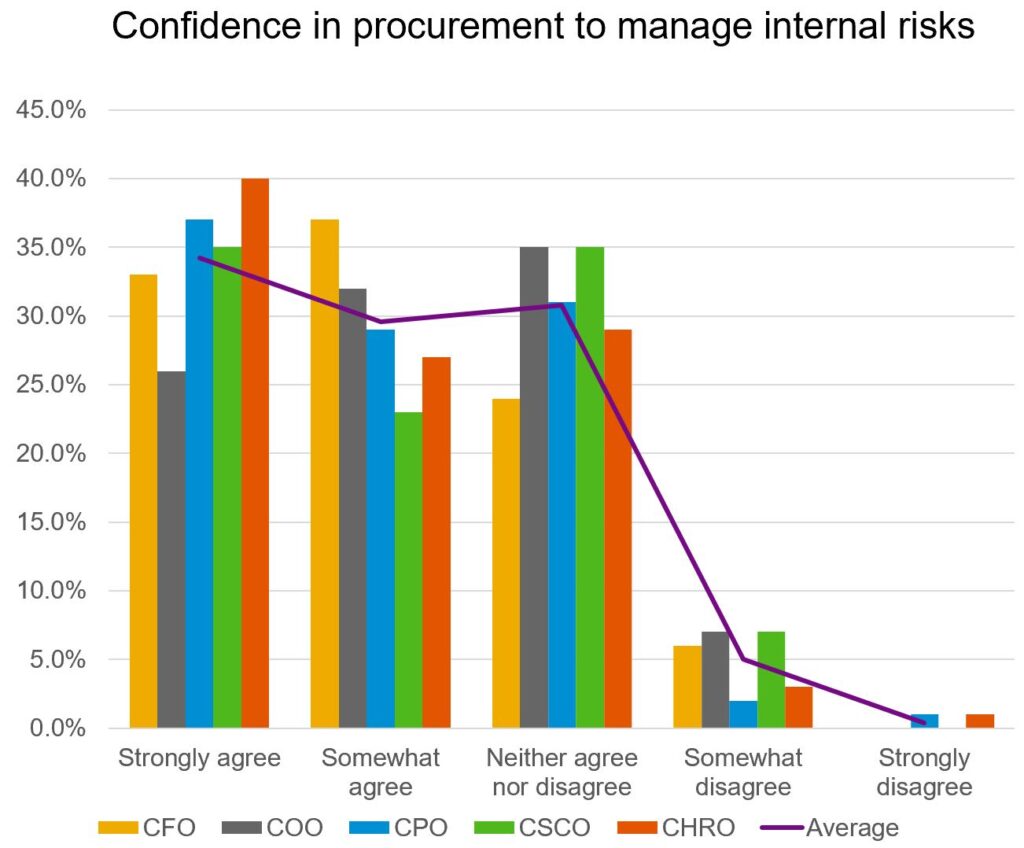Business leaders greatly value the impact that procurement teams can have in their organizations. They’re especially pleased with procurement’s ability to tackle external risk. However, confidence wanes when they consider its ability to collaborate internally.
These are among the findings of a new research study by Economist Impact, sponsored by SAP. The study surveyed 500 executives, including chief financial officers, chief operations officers, chief procurement officers, chief supply chain officers, and chief human resources officers.
The resulting report, Decoding Confidence in the Procurement Function, explores how businesses and industries are transforming procurement to meet existing and emerging challenges.
How Is Procurement Perceived in 2023?
As its title implies, the research report looks at how executives perceive the performance of procurement today and how it needs to evolve for the future. The results are mixed.
Researchers found that that 69.6% of respondents believe the procurement function’s insights are essential for implementing an organization’s strategy – a clear vote of confidence. However, only half (53.2%) of the respondents agree that procurement is effectively collaborating with the rest of the organization to meet the company vision; the figure was less than half (47%) among chief operating officers (COOs), arguably the position best placed to make this assessment given their operational oversight. COOs were also the most likely reporting line for procurement teams in 2022, at 33.5%, giving them deeper insights into the function’s performance.
If you dive further into the survey, you’ll see that procurement has work to do to gain the confidence of the many respondents who aren’t confident in its ability to handle internal risks.
When executives were asked about their confidence in procurement’s ability to manage internal risks, a solid 34% strongly agreed. However, the middle responders – the “somewhat agrees” and “neither agree nor disagrees” – present reason for concern. Let’s call this group the “fence sitters.” About 64% of all respondents were on the fence about procurement’s ability to manage risks internally.

Earning the C-Suite’s Confidence
At a time when procurement is trying to raise its profile within the C-suite, confidence is essential. As procurement works to gain the confidence of its executive stakeholders, here are five key strategies to consider.
Collaboration Is Key
I would argue that for procurement to earn the confidence of fence sitters, the best thing it can do is collaborate proactively with its executive stakeholders. Traditionally, the procurement function has been very good at collaborating externally with the suppliers that are seeking their business. But it doesn’t pay as much attention to the internal teams that rely on its services and expertise. Procurement needs to be as internally focused as it is externally focused.
Meet the Business Where It Is, and Don’t Wait to Get Involved
Too often, we hear complaints from procurement that it’s brought into the process too late – after internal stakeholders have defined scope and specifications and identified a preferred supplier. This limits the function to being a price reducer, rather than a value driver. Think proactively about how procurement can engage earlier with the business, not how the business can engage earlier with procurement.
Make it a priority to get close to the business units you support and understand their needs. Reach out to your stakeholders and meet them face-to-face. Explain how they can engage with procurement, and ask how stakeholders would like to be engaged.
Break Down the Barriers
Oftentimes, a stakeholder executive’s first introduction to procurement is a Web site filled with policies and rules. The reality is that the procurement process necessarily involves a series of approvals and sometimes rejections.
For their part, procurement professionals need to work with stakeholders to understand how this process impacts business results. You can’t change rules and policies on the fly. But you can work with your stakeholders to find ways to break down barriers and make the process more seamless to achieve the best possible outcomes for the business.
Engage with the Business Early to Address Internal Risks
Work collaboratively with your executive stakeholders to address the internal risks procurement typically manages. These include:
- Strategic initiatives: What are the business unit’s plans for the next 12 to 18 months? How will they impact what the business needs to procure? How will plans evolve over the next few years? Can external markets keep pace with the needs of the business?
- Organization alignment: Business units may have differing priorities around cost saving, risk reduction, compliance, sustainability, and efficiency. How are they reconciled, and what does this mean for procurement?
- Insourcing and outsourcing strategies: The 2022 and 2023 Economist Impact surveys, sponsored by SAP, identified changing business operating models as a key priority. Understanding how insourcing and outsourcing help address these priorities is critical.
- Internal relationships: How do differing departments impact each other? What are their relationships, and who are the influencers?
- Forward-looking views: Which projects are up next, and which projects are being stopped?
Improve the Procurement Experience for Internal Buyers
Until now, we’ve focused on ensuring confidence through collaboration with executive stakeholders. But the opinion of everyday internal buyers can have a significant impact on the attitudes of the C-suite. These are the people who purchase business supplies or a new laptop, or secure printing services.
The Economist Impact survey found that improved user experience (UX) was the number one area in which respondents planned to use emerging technologies, such as artificial intelligence (AI), machine learning, and the Internet of Things (IoT), with 34% of respondents selecting this option. At the same time, half the executives cited people/relationship management as vital to UX improvement for procurement.
These days, buyers like this are familiar with how easy it is to buy online, and they want that same experience for their business purchases. Procurement technology, such as the guided buying capability in SAP Ariba solutions, can deliver this experience. And now, the buying 360 capability, demonstrated at SAP Sapphire in 2023, is bringing new services to make purchasing more predictive, personalized, and sustainable. These capabilities can be configured to incorporate procurement policies to ensure internal buyers are purchasing items that comply with corporate policies – in a way that’s transparent to the buyer.
To increase confidence within the C-suite, procurement must show it can work within the business to address internal risks and create value. It all starts with collaboration. Procurement teams need to meet their internal stakeholders where they are and break down the barriers that prevent them from achieving the best outcomes for the business.
Baber Farooq is senior vice president and head of Market Strategy for SAP Procurement Solutions.



